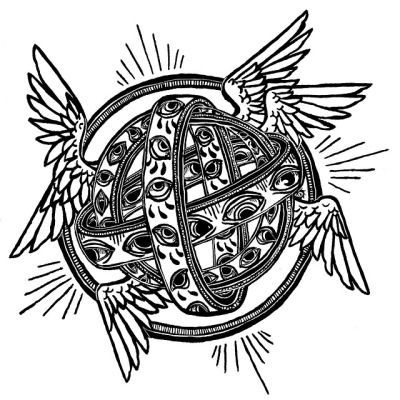Who or What Are the Ophanim, “the Wheels,” in the Bible?
Share

The Bible is full of brilliant imagery. Through His Holy Word, God gives us a glimpse into a realm where human eyes rarely gain access. When we dive into Scripture hungry to know more about God, His ways, and His plans, we never leave disappointed. In the pages of the Bible, the mysteries of the universe, the Heavens, and spiritual beings are divulged so that we can know Him better. The Ophanim reveal our God as King and affirm the sovereignty of His reign.

Artist depiction of Ophanim
What Does The Bible Say About the Ophanim?
In 597 BC, Jehoiachin—king of Judah, a priest named Ezekiel, and 10,000 Jews were captured by invading Babylonians and brought to a village called Tel-abib (Ezekiel 3:15). Five years into their exile, God approaches Ezekiel near a river in Chebar (modern-day Iraq) and inaugurates him for prophetic ministry by showing him an extraordinary vision (Ezekiel 1:1-2).
The Ophanim described in Ezekiel’s vision are impossible to define apart from the full scope of the revelation. In Ezekiel 1, we find a young priest on the precipice of his new calling. As part of God’s great plan to call Israel to repentance, He chooses to open the Heavens before Ezekiel’s temporal eyes.
Ezekiel sees an ominous, fiery, lightning cloud waft toward him from the north. Four illuminated beings blaze brightly within the cloud. Although the beings resemble the form of a man, they are far from mortal. Each has four faces—one human, one lion, one ox, and one eagle. They’re completely covered with eyes, from the top of their heads to the tips of their glowing calf-like feet. Their human-shaped hands tuck inside each of their four wings. One set of wings stretches outward to connect with the wings of their counterparts, while the other set shrouds their own bodies (Ezekiel 1:4-11, Ezekiel 10:12).
The prophet doesn’t record these creatures by name in Ezekiel 1, where the recounting of his vision begins. But by chapter 10 they’re identified as Cherubim. These angelic creatures are the same ones associated with the Ark of the Covenant images (Exodus 25:18–22) and the angels most frequently cited in the Hebrew Bible. They’re known as the guardians of God’s throne, which makes sense when we witness what comes next in Ezekiel’s vision.
Ezekiel is first captivated—and I imagine a little terrified—by the image of four massive and awe-inspiring Cherubim floating toward him in the vision. The angels speed back and forth in flashes like lighting at the sole discretion of God’s Spirit. But then the prophet notices a wheel beneath each cherub. He records the wheels’ appearance like this: “They sparkled like topaz, and all four looked alike. Each appeared to be made like a wheel intersecting a wheel. As they moved, they would go in any one of the four directions the creatures faced; the wheels did not change direction as the creatures went. Their rims were high and awesome, and all four rims were full of eyes all around” (Ezekiel 1:16-18).
These luminescent, interlocking wheels have come to be known as Ophanim, after the ancient Hebrew word meaning wheels. The four Ophanim, guided by the same spirit as the Cherubim in one symbiotic entity (Ezekiel 1:20), are thought to be the “chariot” of God’s throne. As Ezekiel’s vision progresses, the reason for this designation comes to light.
Spread above the heads of the four Cherubim and the Ophanim, Ezekiel sees a crystal vault that is so breathtaking the only human words he can muster to describe it is “awesome.” Above the vault, he sees a vibrant, sparkling throne, and high above the throne, he sees “the appearance of the likeness of the glory of the LORD.” When Ezekiel witnesses the majesty of God’s glory, he immediately falls facedown and hears the thunderous voice of the Almighty instruct him in his mission to bring God’s judgment to rebellious Israel (Ezekiel 1:22-28).
Why Do Some Refer to the Ophanim as Angels?
The Bible never references the Ophanim as angelic beings. But Jewish apocalyptic writers branded them as a class of angels, and lists them in their hierarchy of angels, along with the Seraphim and Cherubim because of the Ophanim’s unique lifelikeness, their supernatural power, and their close proximity to God’s throne—not to mention the multitude of eyes.
Ophanim are still mentioned in traditional Jewish prayers sung by congregations as part of their Shabbat morning service; "The ophanim and the holy living creatures with great uproar raise themselves up; facing the seraphim they offer praise, saying, 'Blessed be God's glory from His place."
Text taken from the Dead Sea Scrolls (4Q405) has also helped further the idea of the Ophanim as angelic beings, as well as late sections of the pseudepigrapha Book of Enoch (61:10, 71:7) where the Ophanim (also spelled ofanim) are described with the Cherubim and Seraphim as “angelic beings who never sleep” while guarding the throne of God.
Whether or not the Ophanim are actually angelic beings or simply a divinely powered mechanism of multidimensional transport doesn’t matter. What does matter is the Ophanim’s role in revealing God’s glory to Ezekiel and every other believer who would one day read his account and gain a fresh vision of God’s Kingship. “For in him all things were created: things in heaven and on earth, visible and invisible, whether thrones or powers or rulers or authorities; all things have been created through him and for him” (Colossians 1:16).
What Do the Ophanim Reveal about God?
In form and function, the Ophanim in Ezekiel’s vision reveals God’s supreme reign over the entire universe. The multidirectional wheels themselves remind us that we serve a God who is omnipresent—able to be in all places at all times.
As the Spirit of God guides the Cherubim (Ezekiel 1:12), that same spirit indwells the Ophanim. “When the creatures moved, they also moved; when the creatures stood still, they also stood still; and when the creatures rose from the ground, the wheels rose along with them, because the spirit of the living creatures was in the wheels” ((Ezekiel 1:20). This symbolic unity of submission displays God’s supreme authority and right to rule and reign—His omnipotence.
And the eyes that cover the wheels and the Cherubim are symbolic of God’s omniscience; He is all-seeing, all-knowing.
In 17 Things the Bible Tells Us about Angels Dr. Roger Barier reminds us that, “The word, ‘angel,’ means messenger. For example, Hebrews 2 tells us that the Angels were the messengers who delivered the Ten Commandments to Moses.” In this respect, the Ophanim may be classified as angels because they literally “carried” the message of God’s sovereign rule to Ezekiel and Israel--and to the entire world through the scriptural account of Ezekiel’s vision.
Why Is it Important for Christians to Know about the Supernatural Realm?
In Ephesians 6:12 we’re told that “our struggle is not against flesh and blood, but against the rulers, against the authorities, against the powers of this dark world and against the spiritual forces of evil in the heavenly realms.” God desires Believers to be aware of the world beyond what our temporal eyes can see so that we, in the Lord’s mighty power, can be prepared to take on whatever scheme the enemy has in store.
We live in a society of extremes. On one end of the spectrum, there are Believers who discount the supernatural aspects of their faith and cling to the naturalistic mindset that relies solely on doctrinal truths for everyday living. And on the other end of the spectrum, there are those so caught up in their fascination with the spiritual realm that they are of no earthly use. We must find the balance God desires for each of His children, and that begins by having our eyes open to the truth.
When Elisha’s servant was terrified by the surrounding enemy in 2 Kings 6:16, the prophet tells the young man, “Don’t be afraid … Those who are with us are more than those who are with them.” He then prays “‘Open his eyes, LORD, so that he may see.’ Then the LORD opened the servant’s eyes, and he looked and saw the hills full of horses and chariots of fire all around Elisha” (2 Kings 6:17).
The world we live in is not our home. There’s an invisible realm where battles rage for our souls. When we choose to explore the Bible and seek God’s understanding of supernatural things, we come that much closer to the Kingdom of God.
In The Duty of Living in the Reality of the Supernatural Alex Crain sums up the grim alternative in this poignant way: “Losing the reality of the supernatural is no small, insignificant detail. It is not an optional feature of true spirituality. When it is absent from our experience, all we are left with is a dead sociological tool; a mere psychological mechanism for manipulating ourselves and other people. As the Apostle Paul said, ‘If in Christ we have hope in this life only, we are of all people most to be pitied’ (1 Corinthians 1:1).”
For more information about living life in the spiritual realm check out A Supernatural Faith by RC Sproul.
Photo credit: ©GettyImages/mouu007